Development of a Performance Analysis Model for Free-Piston Stirling Power Convertor in Space Nuclear Reactor Power Systems
Abstract
:1. Introduction
2. Performance Analysis Model for FPSPC
2.1. The Losses and Quasi Steady Flow Model (LQSFM) for FPSE
2.1.1. Parasitic Heat Losses Model
2.1.2. The Losses and Quasi Steady Flow Model (LQSFM) of Stirling Cycle
2.2. Piston Mechanical Dynamics Analysis Model
2.3. Alternator Analysis Model
3. Solution and Validation of the Model
3.1. Solution of the Model
3.2. Validation of the Model by GPU-3 Engine
4. Performance Analysis of CTPC
4.1. Design Performance Analysis of CTPC
4.2. Effect of Heater and Cooler Temperature
5. Conclusions
Author Contributions
Funding
Institutional Review Board Statement
Informed Consent Statement
Data Availability Statement
Acknowledgments
Conflicts of Interest
References
- IAEA. The Role of Nuclear Power and Nuclear Propulsion in the Peaceful Exploration of Space; International Atomic Energy Agency: Vienna, Austria, 2005. [Google Scholar]
- Ashcroft, J.; Eshelman, C. Summary of NR Program Prometheus Efforts; LM-05K 188; American Institute of Physics: New York, NY, USA, 2006. [Google Scholar]
- Bruno, C. Nuclear Space Power and Propulsion Systems; American Institute of Aeronautics and Astronautics, Inc.: Reston, VA, USA, 2008. [Google Scholar]
- Zhuting, S.; Jicai, Y.; Guotu, K. Space Nuclear Powe; Shanghai Jiaotong University Press: Shanghai, China, 2016. [Google Scholar]
- Marshall, A.C. RSMASS_D Models: An Improved Method for Estimating Reactor and Shield Mass for Space Reactor Applications; SAND91-2876; Sandia National Laboratories: Albuquerque, NM, USA, 1991. [Google Scholar]
- El-Genk, M.S. Space nuclear reactor power system concepts with static and dynamic energy conversion. Energy Convers. Manag. 2008, 49, 402–411. [Google Scholar] [CrossRef]
- Mason, L.S. A Comparison of Brayton and Stirling Space Nuclear Power Systems for Power Levels from 1 Kilowatt to 10 Megawatts; NASA/TM—2001-210593; American Institute of Physics: New York, NY, USA, 2001. [Google Scholar]
- Fission Surface Power Team. Fission Surface Power System Initial Concept Definition; NASA/TM-2010-216772; National Aeronautics and Space Administration, Glenn Research Center: Cleveland, OH, USA, 2010. [Google Scholar]
- Lewandowski, E.; Regan, T. Overview of the GRC Stirling Convertor System Dynamic model. In Proceedings of the 2nd International Energy Conversion Engineering Conference, Providence, RI, USA, 16–19 August 2004. [Google Scholar]
- Thombare, D.G.; Verma, S.K. Technological development in the Stirling cycle engines. Renew. Sustain. Energy Rev. 2008, 12, 1–38. [Google Scholar] [CrossRef]
- Regan, T.; Lewandowski, E. Development of a Linear Stirling System Model with Varying Heat Inputs. In Proceedings of the 5th International Energy Conversion Engineering Conference and Exhibit (IECEC), St. Louis, MO, USA, 25–27 June 2007. [Google Scholar]
- Urieli, I.; Berchowitz, D.M. Stirling Cycle Engine Analysis; Adam Hilger Ltd.: London, UK, 1984. [Google Scholar]
- Timoumi, Y.; Tlili, I.; Nasrallah, S.B. Design and performance optimization of GPU-3 Stirling engines. Energy 2008, 33, 1100–1114. [Google Scholar] [CrossRef]
- Kays, W.M.; London, A.L. Compact Heat Exchangers; McGraw-Hill Book Company: New York, NY, USA, 1964. [Google Scholar]
- Norman, S. Control System Engineering, 4th ed.; California State Polytechnic University: Pomona, CA, USA, 2004. [Google Scholar]
- Little, J.; Gordon, L. Free-piston Stirling Engine/Linear Alternator modeling and simulation. In Proceedings of the NASA Lewis Research Center, Cleveland, OH, USA, 1 August 1990. [Google Scholar]
- Butcher, J.C. Numerical Methods of Ordinary Differential Equations, 2nd ed.; John Wiley & Sons: New York, NY, USA, 2008. [Google Scholar]
- Thieme, L.G. Low-Power Baseline Test Results for the GPU-3 Stirling Engine; NASA-TM-1979-79103; U.S. Department of Energy, Office of Conservation and Solar Applications, Division of Transportation Energy Conservation: Columbus, OH, USA, 1979. [Google Scholar]
- Dhar, M. Stirling Space Engine Program; Final Report, NASA/CR-1999-209164; National Aeronautics and Space Administration, Glenn Research Center: Cleveland, OH, USA, 1999; Volume 1. [Google Scholar]
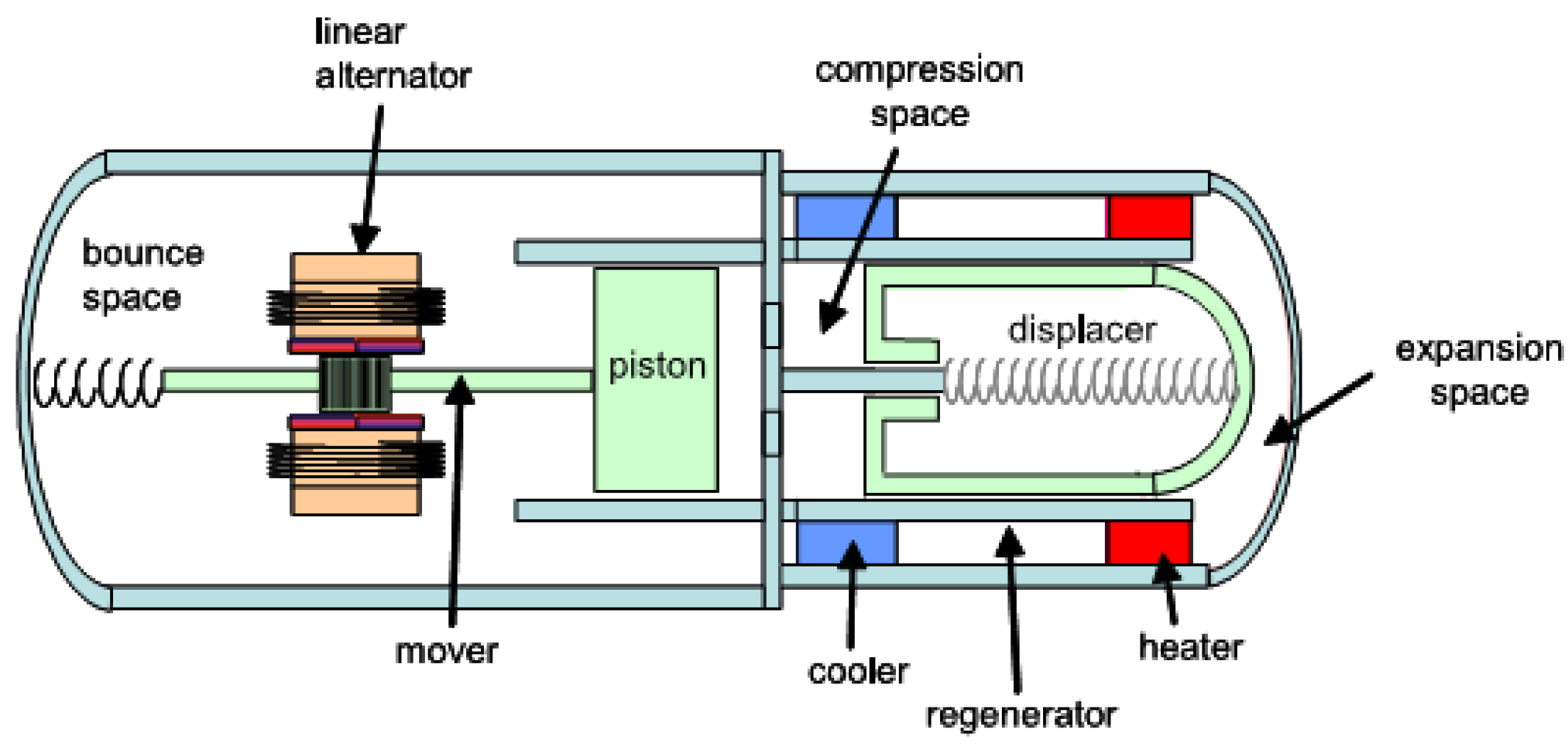
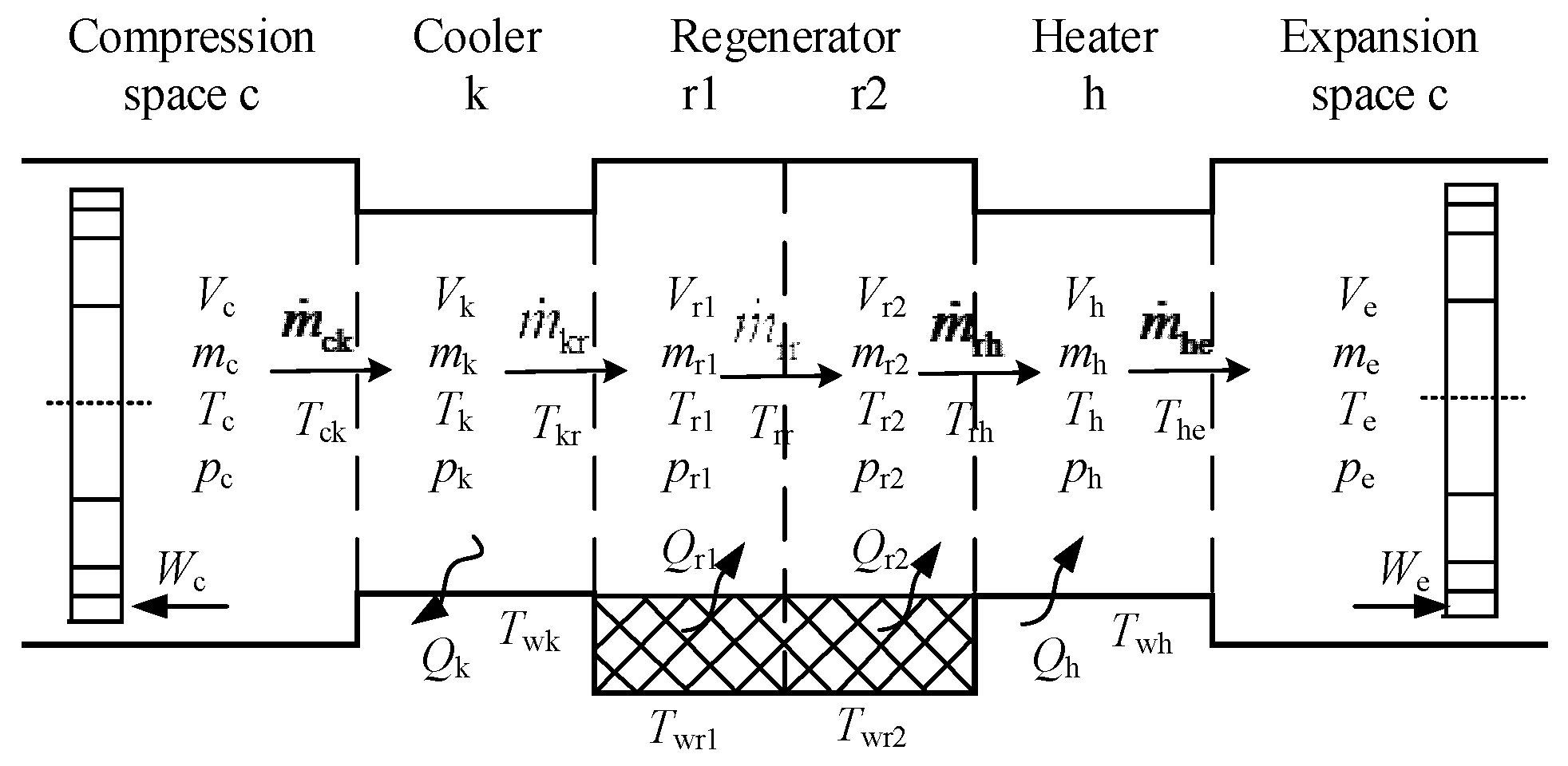
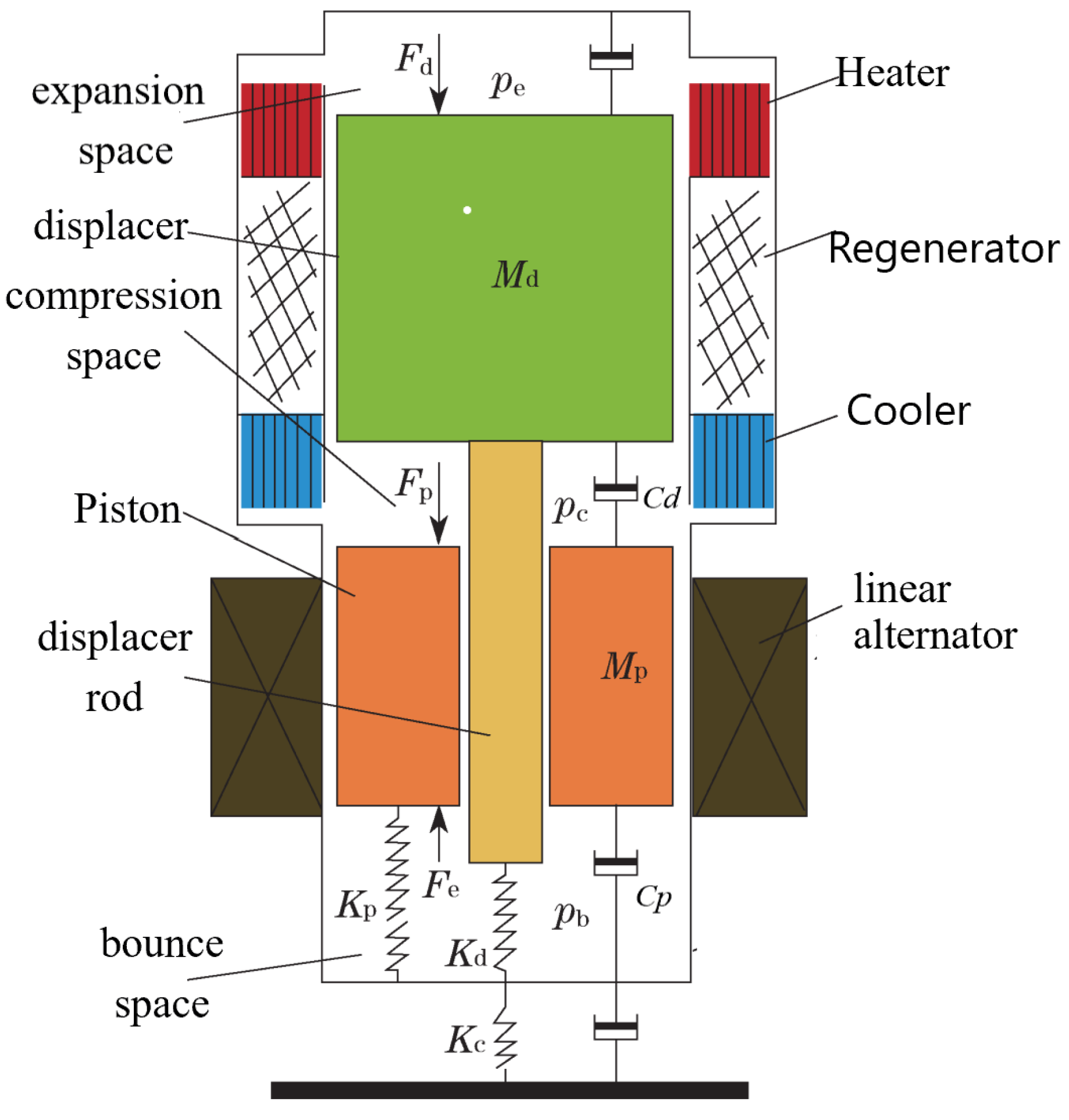
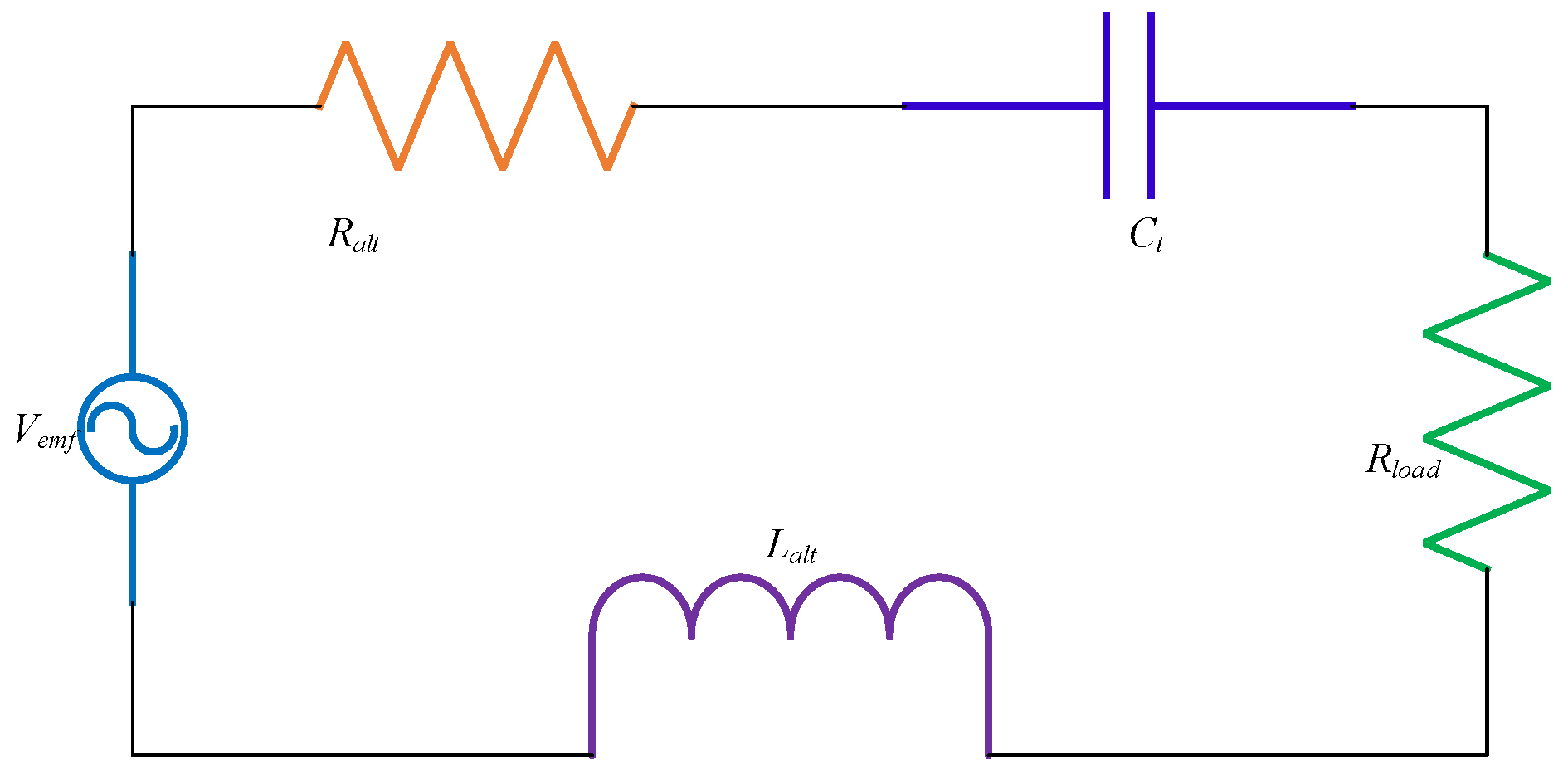
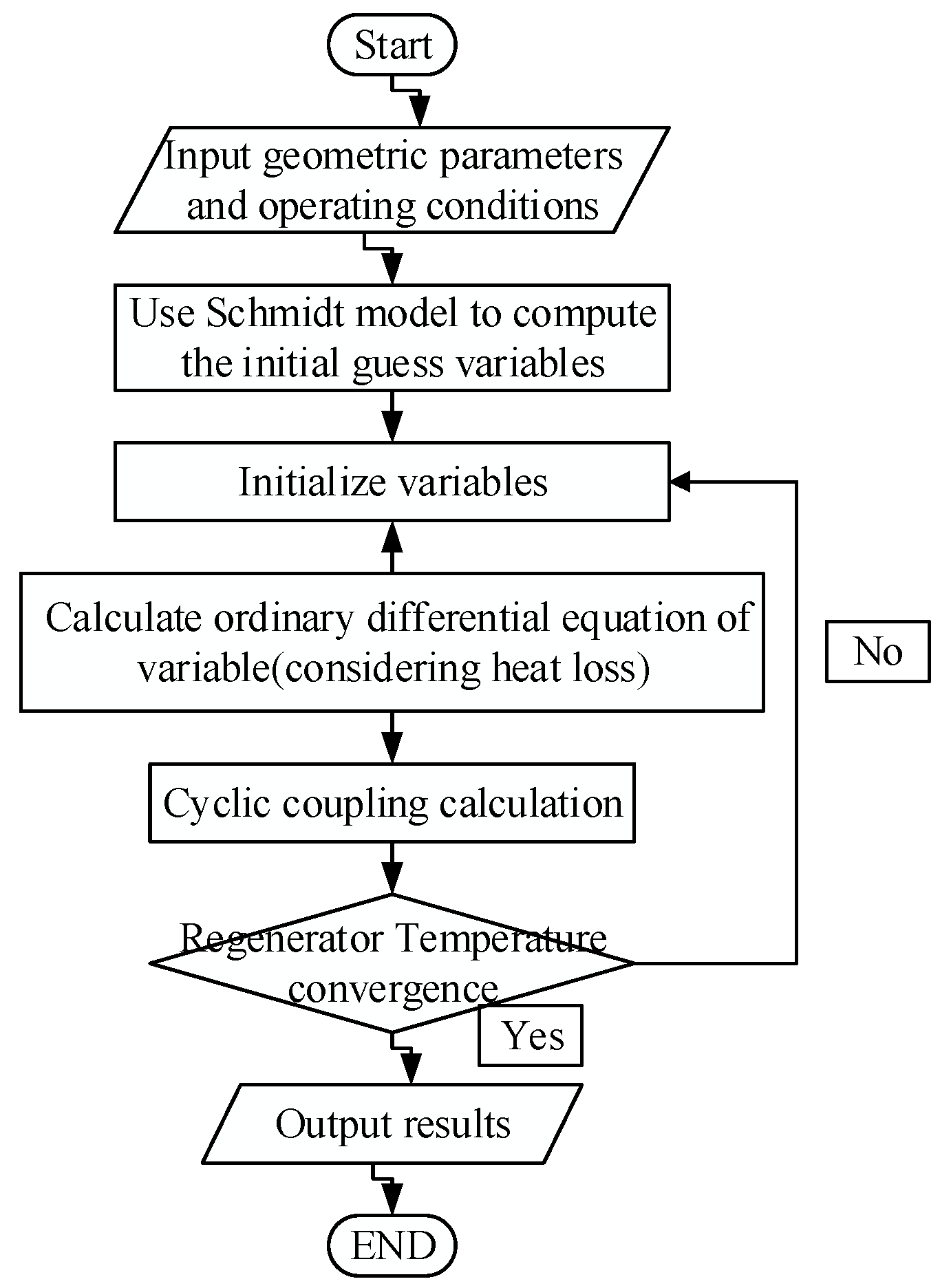
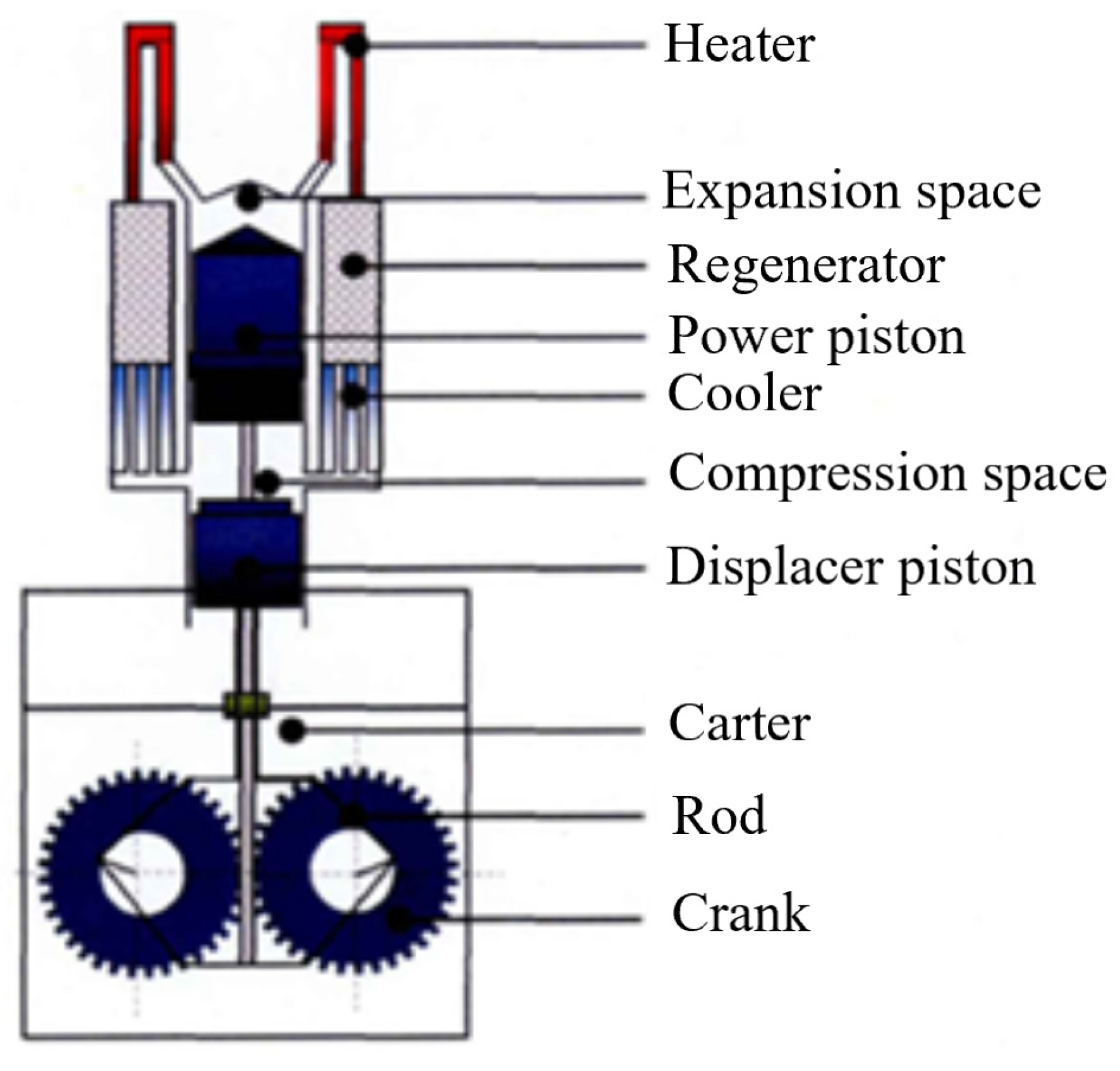

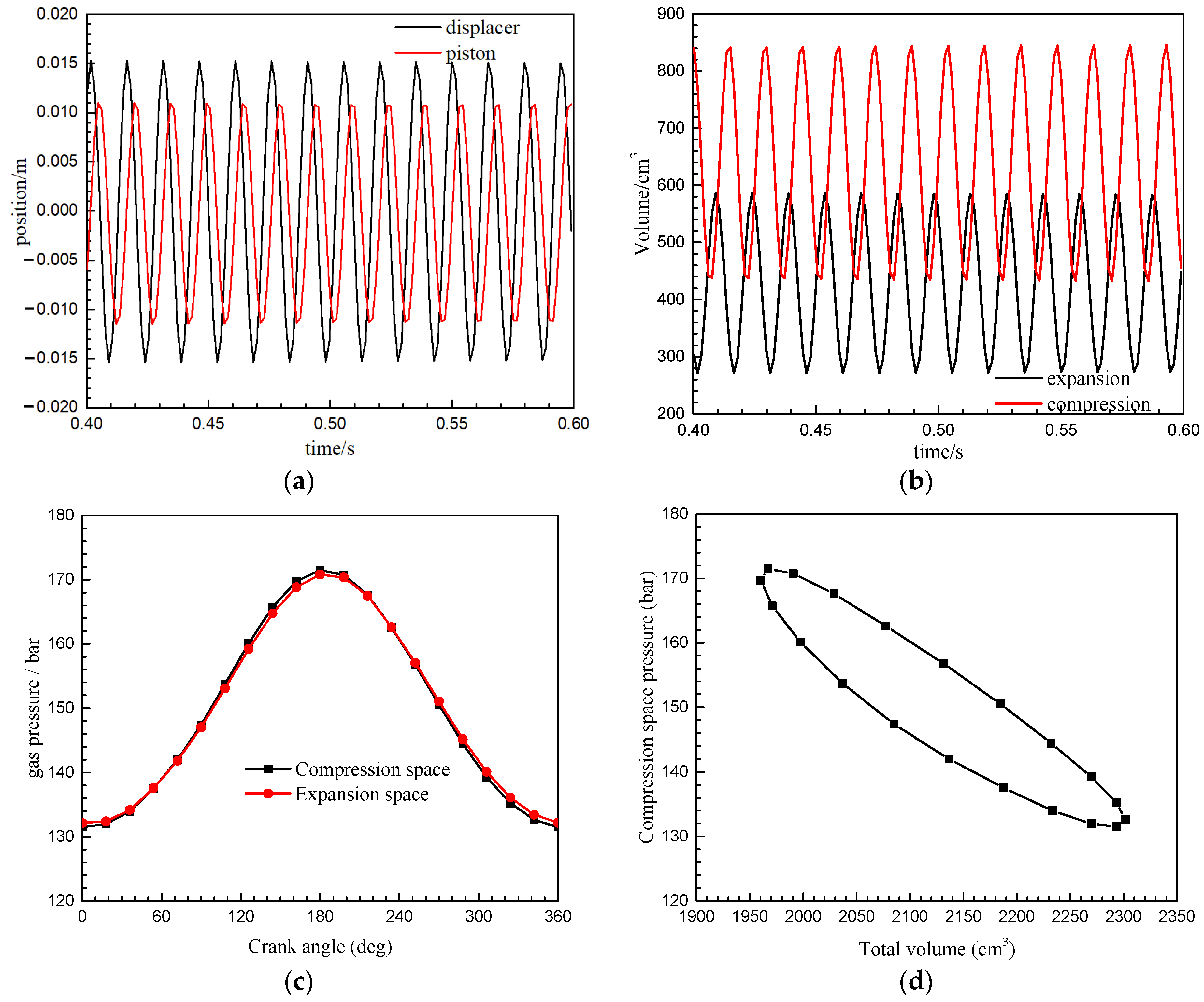
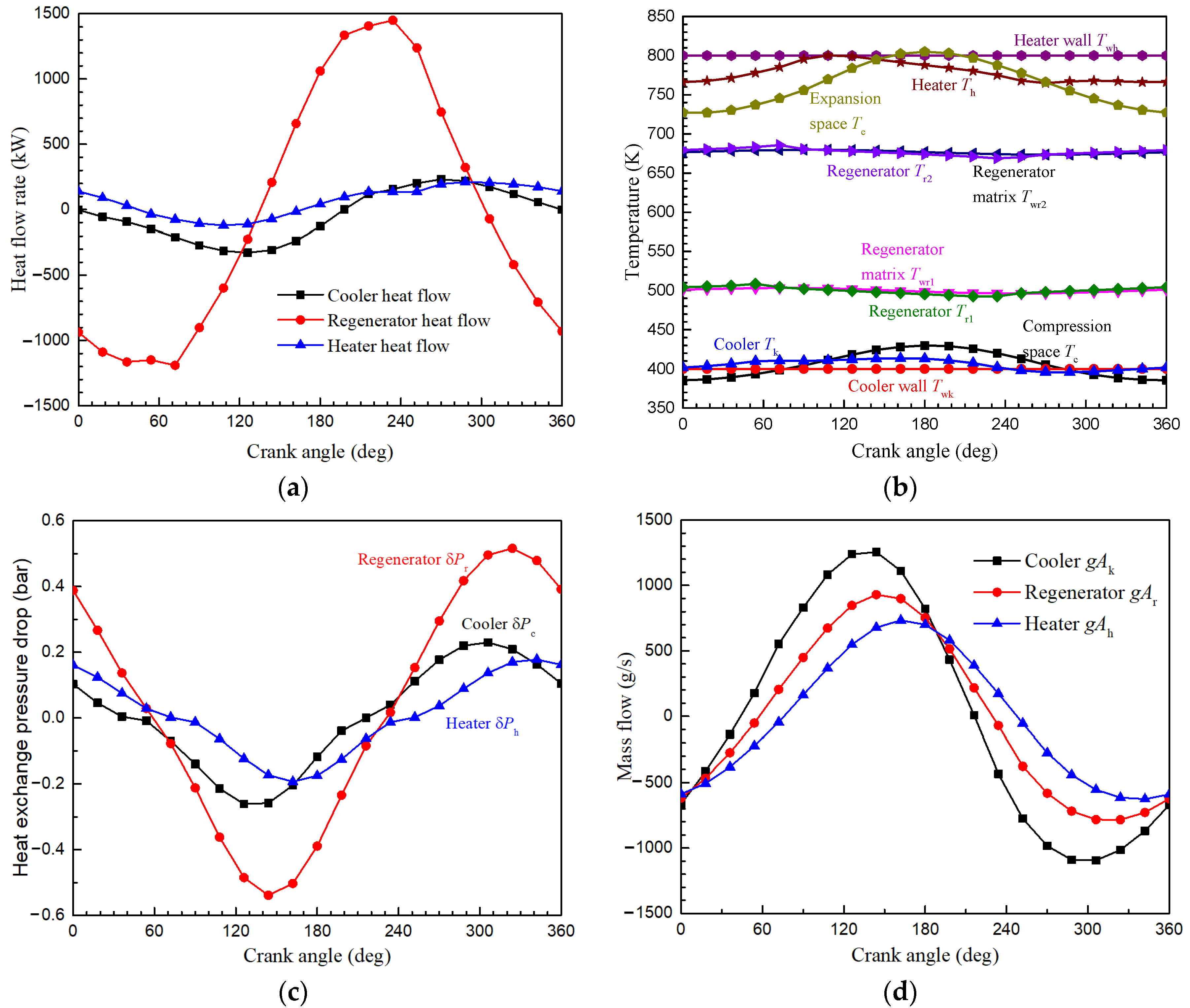

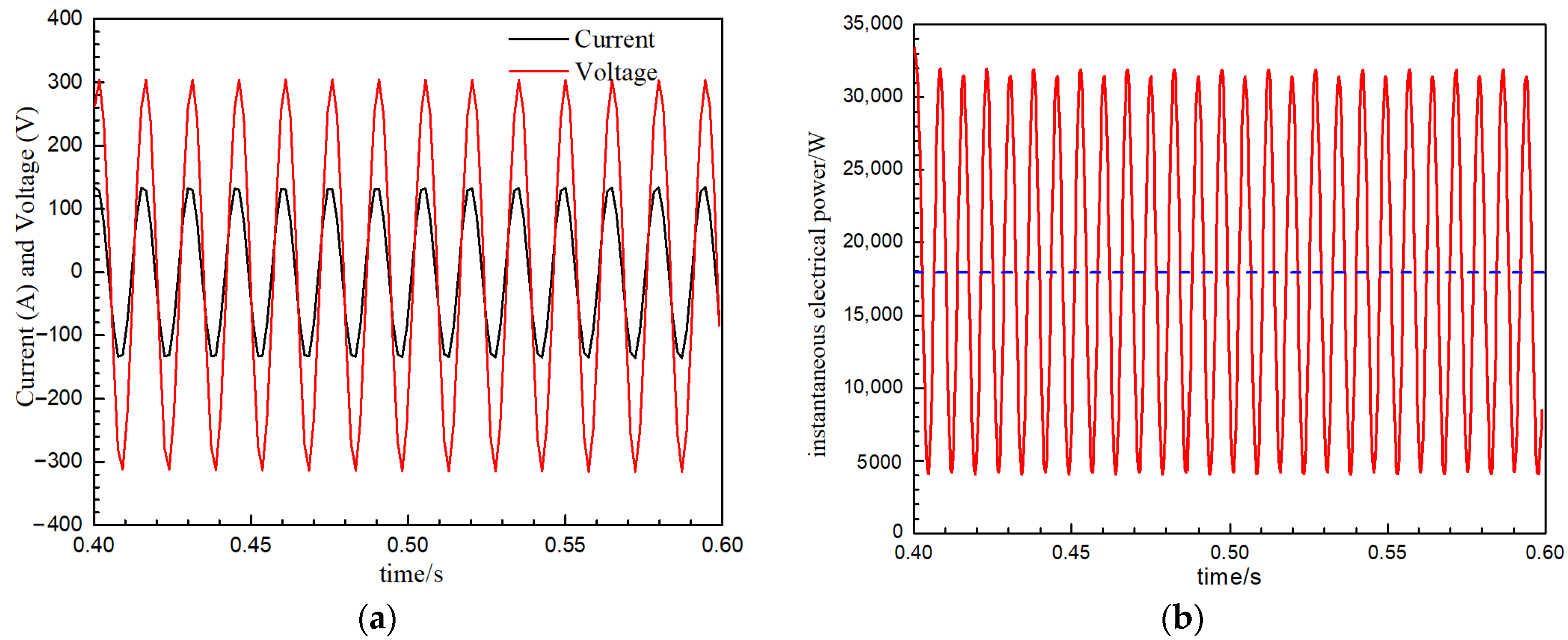
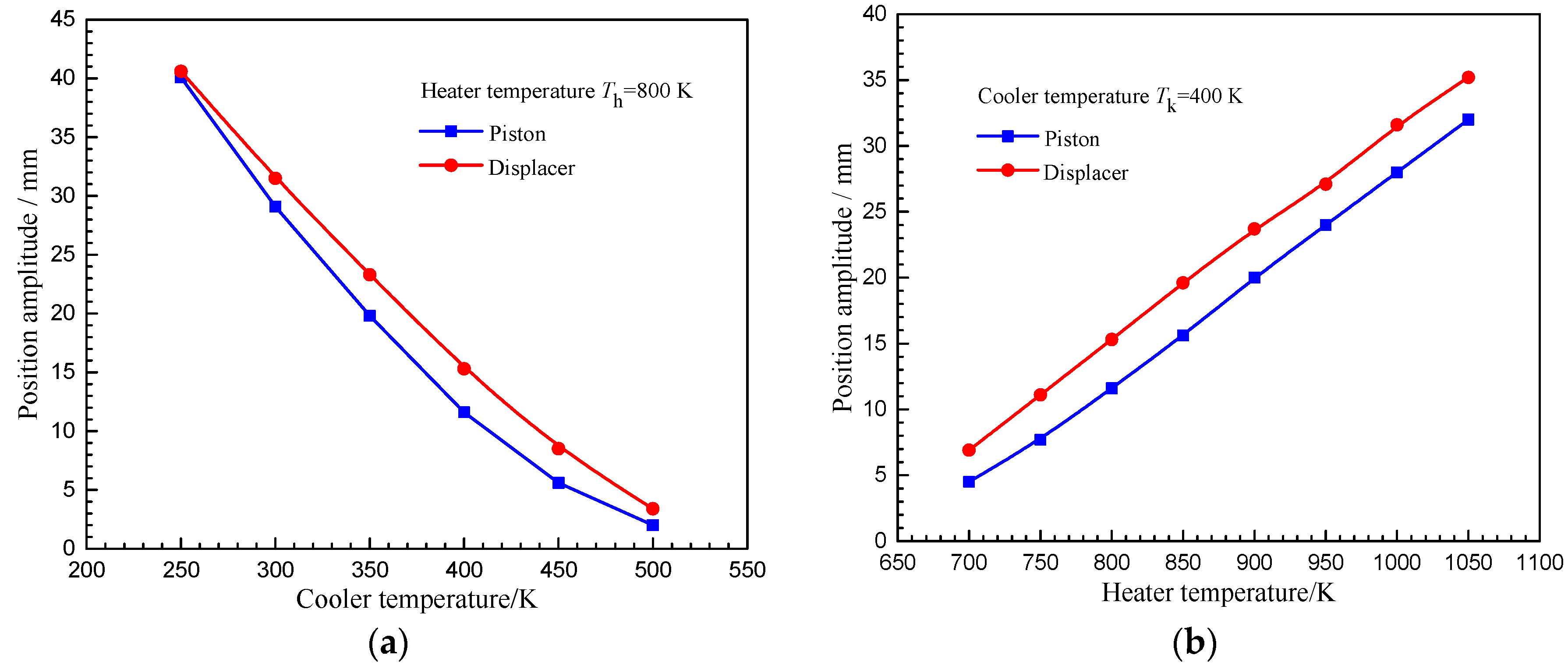
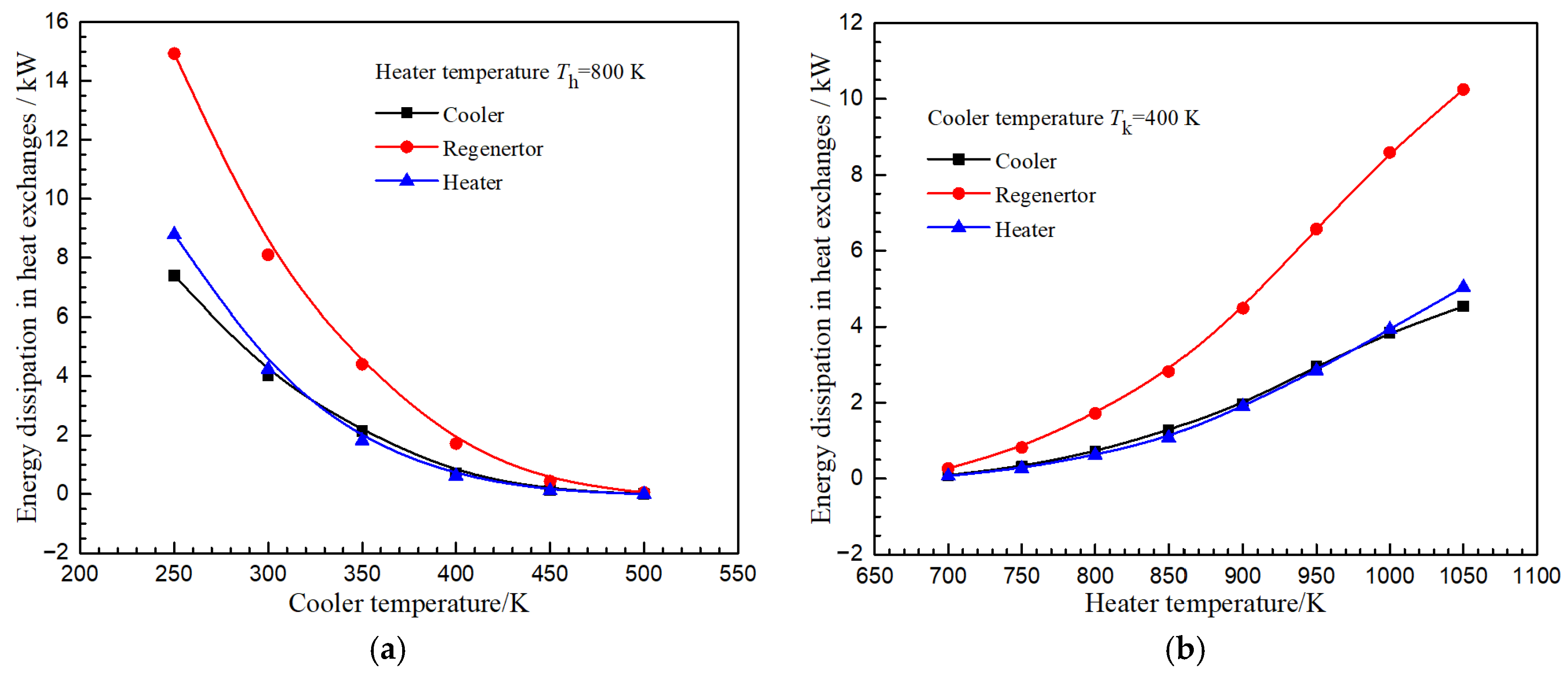
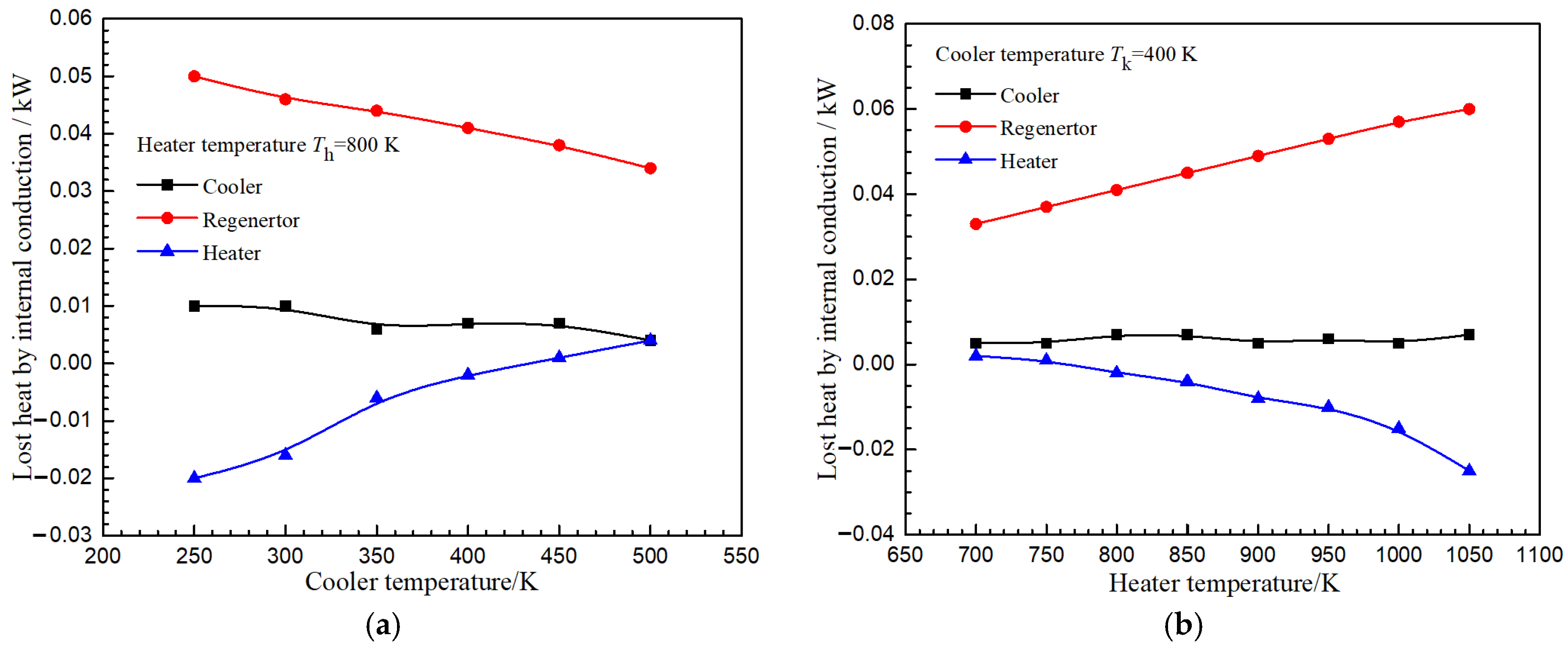

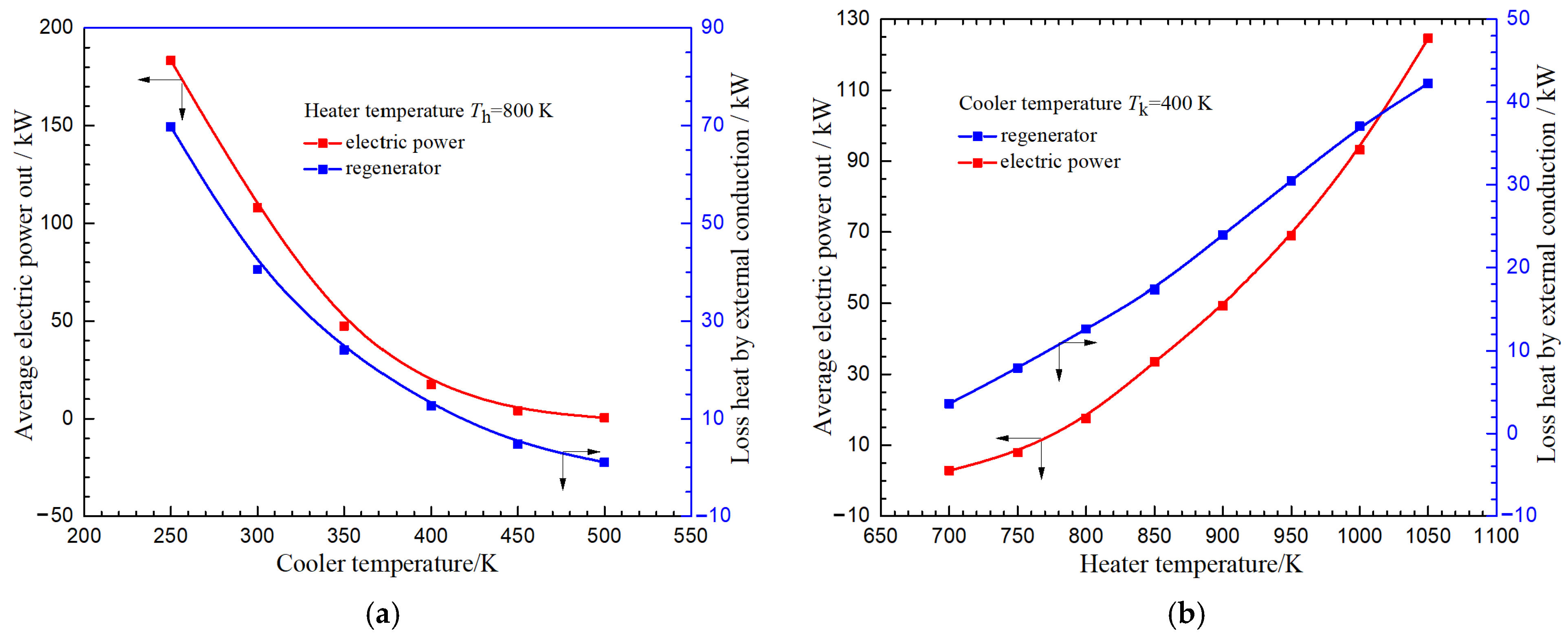
| Parameter | Value |
|---|---|
| Type | Beta |
| Heat temperature Th, K | 977 |
| Heat sink temperature Tc, K | 288 |
| Mean effective pressure, MPa | 4.13 |
| Working gas | Helium |
| Working frequency, Hz | 41.7 |
| Regenerator diameter(inside), mm | 22.6 |
| Regenerator length, mm | 22.6 |
| Number of regenerators per cylinder | 8 |
| Regenerator wire diameter, mm | 0.04 |
| Matrix number of wires, mm | 7.9 × 7.9 |
| Displacer diameter, mm | 69.6 |
| Model | Heat (J/Cycle) | Power Output | Efficiency (%) | |
|---|---|---|---|---|
| W | J/Cycle | |||
| Urieli Quasi-steady flow model [14] (pressure drop including ) = W1 | 6700 | 52.5 | ||
| W1 + Heat conduction loss = (W2) | 299.4 | 6548.3 | 157.0 | 52.4 |
| W2 + Regenerator heat transfer loss = (W3) | 299.6 | 6546.6 | 156.9 | 52.4 |
| W3 + Shuttle heat loss = (W4) | 369.1 | 6238.5 | 149.5 | 40.5 |
| W4 + Gas spring hysteresis loss = LQSFM | 321.7 | 5481.7 | 131.4 | 40.8 |
| GPU-3 test data | 3958 | 35 | ||
| Parameters | Value | Parameters | Value |
|---|---|---|---|
| Block number | 1 | Displacer | |
| type | γ | Material | Inconel 718 |
| Working fluid | Helium | diameter (hot) | 1.143 × 10−1 m |
| Frequency | 70 Hz | area (hot) | 1.0261 × 10−2 m2 |
| Mean pressure | 15 MPa | area (cold) | 9.7902 × 10−3 m2 |
| Heater wall temperature | 800 K | The effective area of connecting rod | 4.708 × 10−4 m2 |
| Cooler wall temperature | 400 K | Length | 3.764 × 10−2 m |
| Piston and displacer amplitude | 14 mm | Piston | |
| Phase angle | 67° | Material | Beryllium |
| Power out | 12.5 kW | Diameter | 1.3716 × 10−1 m |
| Convertor efficiency | >20% | Area | 1.4776 × 10−2 m2 |
| Expansion space | Regenerator | ||
| Wall material | Inconel 718 | Porous materials | SS347 |
| Mean surface area | 7.273 × 10−2 m2 | Wall materials | Inconel 718 |
| Dead volume | 2.2982 × 10−4 m2 | Outside diameter | 2.278 × 10−1 m |
| Average volume | 4.279 × 10−4 m2 | Inside diameter | 1.169 × 10−1 m |
| Heater | Wire diameter | 5.08 × 10-5 m | |
| Number of tubes | 1900 | Length | 3.76 × 10−2 m |
| Tube inside diameter | 1.016 × 10−3 m | Porosity | 0.728 |
| Tube length | 5.969 × 10−2 m | Outside wall thickness | 3.175 × 10−4 m |
| tube wall thickness | 7.5 × 10−4 m | Inside wall thickness | 1.27 × 10−3 m |
| Cooler | Compression space | ||
| Number of ducts | 2580 | Wall material | Beryllium |
| Duct height | 1.464 × 10−3 m | Mean surface area | 9.442 × 10−2 m2 |
| Duct width | 5.334 × 10−4 m | Dead volume | 1.498 × 10−4 m3 |
| Duct length | 7.493 × 10−2 m | Average volume | 6.3529 × 10−4 m3 |
| Parameter | Design Value | 800 K Test Data | FPSC Simulation | Error vs Test Data |
|---|---|---|---|---|
| Power out, W | 12,500 | 12,780 | 17,316 | 35% |
| Current, A | - | 48.09 | 86.38 | 79% |
| Voltage, V | - | 401.0 | 193.15 | −51.8% |
| Frequency, Hz | 70 | 67.45 | 69 | 2.3% |
| xd amplitude, mm | 14 | 14.8 | 15.1 | 2.03% |
| xp amplitude, mm | 14 | 13.44 | 11.2 | −16.67% |
| Mean pressure, bar | 150 | 150 | 149.3 | −0.47% |
| Th, K | 800 | 800 | 800 | - |
| Te, K | - | 776 | 756 | −2.6% |
| Tc, K | - | 418.5 | 405 | −3.22% |
| Tk, K | 400 | 400 | 400 | - |
Publisher’s Note: MDPI stays neutral with regard to jurisdictional claims in published maps and institutional affiliations. |
© 2022 by the authors. Licensee MDPI, Basel, Switzerland. This article is an open access article distributed under the terms and conditions of the Creative Commons Attribution (CC BY) license (https://creativecommons.org/licenses/by/4.0/).
Share and Cite
Li, H.; Tian, X.; Ge, L.; Kang, X.; Zhu, L.; Chen, S.; Chen, L.; Jiang, X.; Shan, J. Development of a Performance Analysis Model for Free-Piston Stirling Power Convertor in Space Nuclear Reactor Power Systems. Energies 2022, 15, 915. https://doi.org/10.3390/en15030915
Li H, Tian X, Ge L, Kang X, Zhu L, Chen S, Chen L, Jiang X, Shan J. Development of a Performance Analysis Model for Free-Piston Stirling Power Convertor in Space Nuclear Reactor Power Systems. Energies. 2022; 15(3):915. https://doi.org/10.3390/en15030915
Chicago/Turabian StyleLi, Huaqi, Xiaoyan Tian, Li Ge, Xiaoya Kang, Lei Zhu, Sen Chen, Lixin Chen, Xinbiao Jiang, and Jianqiang Shan. 2022. "Development of a Performance Analysis Model for Free-Piston Stirling Power Convertor in Space Nuclear Reactor Power Systems" Energies 15, no. 3: 915. https://doi.org/10.3390/en15030915
APA StyleLi, H., Tian, X., Ge, L., Kang, X., Zhu, L., Chen, S., Chen, L., Jiang, X., & Shan, J. (2022). Development of a Performance Analysis Model for Free-Piston Stirling Power Convertor in Space Nuclear Reactor Power Systems. Energies, 15(3), 915. https://doi.org/10.3390/en15030915






